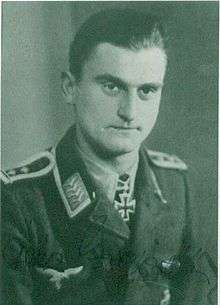Heinz Marquardt
| Heinz Marquardt | |
|---|---|
 Heinz Maraquardt | |
| Nickname(s) | "Negus" |
| Born |
29 December 1922 Braunsberg, East Prussia, (now Poland) |
| Died |
19 December 2003 (aged 80) Hammersbach |
| Allegiance |
|
| Service/branch |
|
| Years of service |
1939–45 1956–73 |
| Rank |
Leutnant (Wehrmacht) Oberstleutnant (Bundeswehr) |
| Unit |
Jagdgeschwader 51 Jagdgeschwader 73 |
| Battles/wars |
World War II |
| Awards | Knight's Cross of the Iron Cross |
| Other work | Condor |
Heinz "Negus" Marquardt (29 December 1922 – 19 December 2003) was a German Luftwaffe fighter ace and recipient of the Knight's Cross of the Iron Cross (Ritterkreuz des Eisernen Kreuzes) during World War II. The Knight's Cross of the Iron Cross was awarded to recognise extreme battlefield bravery or successful military leadership. Marquardt was credited with 121 aerial victories—that is, 121 aerial combat encounters resulting in the destruction of the enemy aircraft—with a further 16 unconfirmed victories in 320 combat missions. All but one of his victories were claimed over the Eastern Front.
World War II
Marquardt was posted to the Jagdfliegerschule 5 (fighter pilot school), stationed at the Le Havre – Octeville airfield in France, on 15 September 1941. There on 1 February 1942, he served as a fighter pilot instructor. He flew a number of operational sorties on the Channel Front in 1942. On 1 August 1943, he was transferred to the 10. Staffel (10th squadron) of Jagdgeschwader 51 "Mölders" (JG 51—51st Fighter Wing) operating on the Eastern Front. On 14 April 1945, Marquardt was credited with his 100th aerial victory. He was the 102nd Luftwaffe pilot to achieve the century mark.[1] On a transfer flight of new Focke-Wulf Fw 190 D-9 to his unit, he was credited with four aerial victories over Yakovlev Yak-3 on 25 April 1945.[2]
On 1 May 1945 Marquardt became Jagdgeschwader 51's last casualty of the war when he was shot down by Royal Air Force Spitfires north of Berlin.[3] Marquardt had led a flight of six Focke Wulf Fw 190 D-9 on an escort mission of 12 Fw 190 F-8 ground attack aircraft from Redlin on a mission to Berlin. After completing the mission the aircraft returned to Schwerin. During the landing approach the flight came under attack of 6 Spitfire Mk XIV from No. 41 Squadron. Marquardt ordered his flight to cover the landing of the ground attack fighters while he and his wingman, Feldwebel Radlauer, attacked the Spitfires from below. Marquardt claimed one of the attackers but was shot down as well along with two other Fw 190s. Radlauer saw Marquardt's Fw 190 crash in flames but did not observe any sign of life. Marquardt was initially reported as killed in action but he had bailed out injured and was taken to a hospital in Schwerin, where he was taken prisoner of war shortly after.[2]
Later life
Following World War II, Marquardt served in the newly established West German Luftwaffe in the Bundeswehr. He joined the Bundesluftwaffe, with the rank of Leutnant (Second Lieutenant) on 16 August 1956. He served with Jagdgeschwader 73 (JG 73—73rd Fighter Wing) and Leichtes Kampfgeschwader 42 (LeKG 42—42nd Light Combat Wing). Marquardt retired on 30 September 1973, having risen to the rank of Oberstleutnant (Lieutenant Colonel). He died on 19 December 2003.
Awards
- Honor Goblet of the Luftwaffe (26 July 1944)[4]
- Iron Cross (1939) 2nd and 1st Class
- German Cross in Gold on 10 September 1944 as Oberfeldwebel in the 10./JG 51[5]
- Knight's Cross of the Iron Cross on 18 November 1944 as Fahnenjunker-Oberfeldwebel and pilot in the 13./JG 51 "Mölders"[6][Note 1]
Notes
- ↑ According to Scherzer as Oberfeldwebel in the 13./JG 51 "Mölders".[7]
References
Citations
Bibliography
- Aders, Gebhard; Held, Werner (1993). Jagdgeschwader 51 'Mölders' Eine Chronik – Berichte – Erlebnisse – Dokumente [Fighter Wing 51 'Mölders' A Chronicle - Reports - Experiences - Documents] (in German). Stuttgart, Germany: Motorbuch Verlag. ISBN 978-3-613-01045-1.
- Fellgiebel, Walther-Peer (2000) [1986]. Die Träger des Ritterkreuzes des Eisernen Kreuzes 1939–1945 — Die Inhaber der höchsten Auszeichnung des Zweiten Weltkrieges aller Wehrmachtteile [The Bearers of the Knight's Cross of the Iron Cross 1939–1945 — The Owners of the Highest Award of the Second World War of all Wehrmacht Branches] (in German). Friedberg, Germany: Podzun-Pallas. ISBN 978-3-7909-0284-6.
- Obermaier, Ernst (1989). Die Ritterkreuzträger der Luftwaffe Jagdflieger 1939 – 1945 [The Knight's Cross Bearers of the Luftwaffe Fighter Force 1939 – 1945] (in German). Mainz, Germany: Verlag Dieter Hoffmann. ISBN 978-3-87341-065-7.
- Patzwall, Klaus D.; Scherzer, Veit (2001). Das Deutsche Kreuz 1941 – 1945 Geschichte und Inhaber Band II [The German Cross 1941 – 1945 History and Recipients Volume 2] (in German). Norderstedt, Germany: Verlag Klaus D. Patzwall. ISBN 978-3-931533-45-8.
- Scherzer, Veit (2007). Die Ritterkreuzträger 1939–1945 Die Inhaber des Ritterkreuzes des Eisernen Kreuzes 1939 von Heer, Luftwaffe, Kriegsmarine, Waffen-SS, Volkssturm sowie mit Deutschland verbündeter Streitkräfte nach den Unterlagen des Bundesarchives [The Knight's Cross Bearers 1939–1945 The Holders of the Knight's Cross of the Iron Cross 1939 by Army, Air Force, Navy, Waffen-SS, Volkssturm and Allied Forces with Germany According to the Documents of the Federal Archives] (in German). Jena, Germany: Scherzers Militaer-Verlag. ISBN 978-3-938845-17-2.
- Weal, John (1998). Focke-Wulf Fw 190 Aces of the Russian Front. Oxford: Osprey. ISBN 1-85532-518-7.
External links
- "Heinz Marquardt". Aces of the Luftwaffe. Retrieved 18 February 2012.